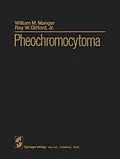This monograph, which was more than five years in preparation, represents a very detailed account of pheochromocytoma, a tumor that is almost invariably lethal if untreated. In addition to its definitive presentation of the subject, this volume contains the most cur rent information regarding the diagnosis and management of pheochromocytoma. It is im portant to reemphasize the seriousness of diagnosing and treating pheochromocytoma with the aphorism of Esperson and Dahl Iversen that although a pheochromocytoma may be morphologically benign it is physio logically malignant (280) and with Aranow's characterization of this tumor as a "veritable pharmacological bomb" (20). If managed ap propriately by a highly skilled and profes sional "bomb squad," this tumor can be re moved and the patient cured in at least 90 percent of cases. The secret lies in first sus pecting and recognizing the patient who has and then offering the ex pheochromocytoma pert management such a patient requires. These facts more than justify this publication, since the internist, pediatrician, obstetrician, ophthalmologist, otolaryngologist, urologist, neurologist, surgeon, anesthesiologist, derma tologist, psychiatrist, radiologist, and also the dentist must be made acutely aware of the varied manifestations of this condition and of the pathologic entities which sometimes co- xiv Preface exist with pheochromocytoma. Furthermore, have included a large number of instructive they should have a thorough knowledge of the figures and have emphasized teaching tables.
Inhalt
1 Background and Importance.- Magnitude of the Hypertensive Problem.- Incidence of Pheochromocytoma.- Historical.- 2 Catecholamine Metabolism: Biosynthesis, Storage, Release, and Inactivation.- General Remarks.- Nomenclature, Occurrence, and Metabolism.- Sympathetic Nerves.- Biosynthesis, Storage, and Release of Norepinephrine.- Inactivation of Norepinephrine.- Catabolism.- Uptake and Binding.- Reuptake Mechanism.- Chromaffin Cells.- Biosynthesis, Storage, Release, and Inactivation.- Pheochromocytomas.- Biosynthesis.- Concentration of Biogenic Amines, Metabolites, and Dopa.- Differences between Adrenal Medulla and Pheochromocytoma in Storage, Release, and Inactivation of Catecholamines.- 3 Origin, Pathopharmacology, and Pathology.- Nomenclature.- Extraadrenal Paragangliomas of Uncertain Classification.- Carotid Body Paraganglioma.- Jugular Paraganglioma.- Laryngeal Paraganglioma.- Supraaortic and Aorticopulmonary Paragangliomas.- Pulmonary Paraganglioma.- Orbital Paraganglioma.- Intravagal Paraganglioma.- Comment.- Embryology.- Etiology (Sporadic and Familial).- Age of Occurrence and Sex Predilection.- Location.- Weight and Size.- Physiologic and Pharmacologic Effects.- Gross and Microscopic Appearance.- Ultrastructure.- Malignant Pheochromocytoma.- Pathologic Complications.- 4 Clinical Manifestations.- Frequency and Occurrence of Attacks.- Symptoms.- Headaches.- Excess Sweating.- Palpitations, Tachycardia, and Bradycardia.- Anxiety, Tremulousness, Nausea, Vomiting, and Faintness.- Chest and Abdominal Pain.- Weakness, Fatigue, and Prostration.- Weight Loss.- Dyspnea.- Warmth and Heat Intolerance.- Visual Disturbance.- Constipation.- Paresthesias and Pain in Extremities.- Grand Mal.- Miscellaneous.- Signs.- Hypertension (Sustained and/or Paroxysmal).- Orthostatic Hypotension.- Postural Tachycardia.- Paradoxic Blood Pressure Response.- Generalized Sweating.- Tachycardia and Reflex Bradycardia.- Pallor and Flushing.- Anxiety.- Retinopathy.- Weight Loss.- Tremor.- Raynaud's Phenomenon.- Fever.- Neurofibromatosis.- Palpable Mass in the Abdomen or Neck.- Swelling of the Thyroid Gland.- Miscellaneous.- Apnea or Tachypnea.- Heart Murmurs and Bruits.- Growth Defects.- Signs of Complications.- Circulatory Shock.- Gastrointestinal Disturbances.- Miscellaneous.- Atypical Manifestations.- Pheochromocytoma in Children.- Pheochromocytoma in Pregnancy.- Pheochromocytoma of the Urinary Bladder.- Pathologic Entities Sometimes Associated with Pheochromocytoma.- Cholelithiasis.- Medullary Thyroid Carcinoma.- Hyperparathyroidism.- Multiple Endocrine Neoplasia, Type 2 and Type 3.- Cushing's Syndrome.- Adrenal Virilism.- Addison's Disease.- Neurocutaneous Lesions.- Neurofibromatosis.- Mucosal Neuromas.- von Hippel-Lindau Disease.- Acromegaly.- Miscellaneous.- 5 Differential Diagnosis.- General Remarks.- Hypertension.- Anxiety or Psychiatric Disorder.- Hyperthyroidism.- Paroxysmal Tachycardia (Atrial and Nodal).- Hyperdynamic ?-Adrenergic Circulatory State.- Menopause.- Vasodilating Headaches.- Migraine Headache.- Cluster Headache.- Coronary Insufficiency Syndrome.- Acute Hypertensive Encephalopathy.- Diabetes Mellitus.- Renal Parenchymal or Renal Arterial Disease with Hypertension.- Focal Arterial Insufficiency of the Brain.- Intracranial Lesions (With or Without Increased Intracranial Pressure).- Autonomic Hyperreflexia.- Diencephalic Seizure (Autonomic Seizure or Epilepsy; Visceral Seizures) and Syndrome.- Toxemia of Pregnancy (Preeclampsia and Eclampsia).- Hypertensive Crises and Monoamine.- Oxidase Inhibitors.- Carcinoid Tumors.- Hypoglycemia.- Mastocytosis.- Familial Dysautonomia (Riley-Day Syndrome).- Acrodynia ("Pink Disease").- Neuroblastoma, Ganglioneuroblastoma, and Ganglioneuroma.- Acute Infectious Disease.- Rare Causes of Paroxysmal Hypertension.- Acute Intermittent Porphyria.- Acute or Chronic Lead Poisoning.- Tabetic Crisis in Tabes Dorsalis.- Acute Encephalitis.- Clonidine Withdrawal.- Hypovolemia with Inappropriate Reflex Vasoconstriction.- Fibrosarcoma of the Pulmonary Artery.- Pork Ingestion.- Hypothalamic Dysregulation.- Tetanus.- Guillain-Barré Syndrome.- Factitious Production of Paroxysmal Hypertension.- Fortuitous Circumstances Simulating Pheochromocytoma.- Potential Secondary Diagnoses.- 6 Diagnosis.- General Remarks.- A Guide for Screening.- Pheochromocytoma "Pearls".- Laboratory Findings.- Blood Glucose, Glycosuria, and Glucose Tolerance.- Basal Metabolism.- Plasma Free Fatty Acids (FFA).- Serum Cholesterol.- Peripheral Blood Counts and Red Cell Volume.- Plasma and Total Blood Volume.- Blood Urea.- Proteinuria.- Plasma Renin and Aldosterone.- Chemical Abnormalities Due to Associated Conditions.- Electrocardiographic Changes.- Clinical.- Experimental.- Concluding Remarks.- Pharmacologic Tests in the Diagnosis of Pheochromocytoma.- Methods of Pharmacologic Testing.- Provocative Tests.- ?-Adrenergic Blocking Test.- Biochemical Tests.- Urine Assays.- Experience at National Institute of Health.- Experience at Mount Sinai Medical Center, New York City.- Experience at the Mayo Clinic.- Experience at the Cleveland Clinic.- Remarks Concerning the Excretion of Dopamine.- Effect of Diet and Drugs.- Authors' Views Regarding Diagnosis of Pheochromocytoma by Urine Assay.- Plasma Assays.- Results Using the Ethylenediamine Method Employed by Manger and Coworkers.- Results Using the Double-Isotope Method of Engelman and Portnoy.- Comment on Double-Isotope Method.- Results Using Modifications of the Trihydroxyindole Fluorometric Method for Assay of Plasma Catecholamines.- Effects of Pharmacologic Tests and Hypertensive Episodes on Blood Pressure and Plasma Catecholamines.- Preoperative Localization of Pheochromocytoma.- Radiographic Techniques.- Abdominal x-Rays.- Intravenous Pyelography and Survey Films.- Nephrotomography.- Computerized Axial Tomography.- Retroperitoneal Pneumography.- Angiography (Arteriography and Venography).- Unusual Radiologic Features.- Isotopic Localization of Adrenal Pheochromocytoma.- Chest, Neck, and Head x-Rays.- Radiologic Manifestations of Diseases Associated with or Complicating Pheochromocytoma.- Central Venous Blood Sampling for Catecholamine Assay.- 7 Studies on 38 Patients with Pheochromocytoma in Whom Catecholamines Were Determined.- Case Reports.- Special Case Report-Pheochromocytoma Masquerading as Eclampsia.- Major Complaints and Findings among Patients…
